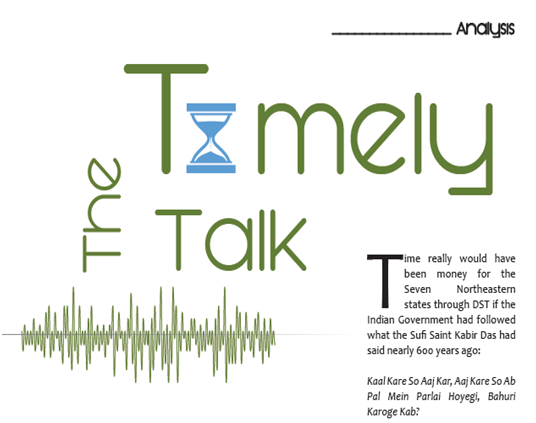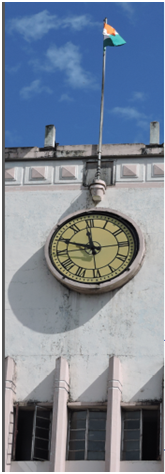
If you ask an Italian why time is important, he will say “Il tempo è Denaro:” time is money, money is time.
But how a Hindustanis would react to this question? Well! He will reply: “We have neither time nor money.” He is right. The Hindustanis hardly are bothered about time, timely decisions. No wonder they don’t have enough money.
If the Indian Government really had time-conscious, it would have corrected the aberrations in the Indian Standard Time (IST) way back in 2006 when the Planning Commission suggested that the country may have two time-zones. This would have meant implementing the Daylight Saving Time or DST for the Northeast saving electricity bills by huge proportion.
(Do tomorrow’s work today, today’s work now. If the doomsday comes, can you complete the incomplete works?)
Just see how the Hindustanis feel about this Doha or couplet of Kabir:
Aaj Kare So Kal Kar, Kal Kare So Parso
Itni Bhi Kya Jaldi Hai, Jab Jina Hai Barso?
 (Defer today’s things tomorrow and tomorrow’s things day after. What is so urgency of completing things in time when you are going to live for years?)
(Defer today’s things tomorrow and tomorrow’s things day after. What is so urgency of completing things in time when you are going to live for years?)
Are you left with any doubt the Centre is following this distorted version Kabir’s couplet on matters of special time-zone for the Northeastern India?
Need for Special Northeast Time-Zone
Can a single time-zone operate in a vast country whose boundaries span about 3,000 km from east to west, north to south? No! Not at all!
Our earth is divided into 360 vertical lines or longitudes. A shift in every longitude gives a time difference of 4-minutes and every 15-degree longitudinal shift causes a time difference of one hour. However, India is having one exclusive IST despite the fact that the time-difference between Kibithu in Arunachal Pradesh and Gugariyana in Gujarat is 2-hours.
The clocks in Assam, Meghalaya, Nagaland, Arunachal Pradesh, Manipur, Mizoram and Tripura run 1-hour ahead of clock in the rest of India. The National Physical Laboratory (NPL) says it is feasible to implement 2-ime-zones: one for Northeast and one for rest of India. The NPL, thus, mooted for 2-versions of the IST.
The sun rises and sets in the Northeast much earlier than the rest of India proving it requires a separate IST on the basis of DST. The NPL study says the Northeast can save 20 million kWh electricity annually, it is given a separate time-zone.
Launched on September 1, 1947, the IST, five and a half hours ahead of the Greenwich Mean Time (+5.30 GMT), is an anachronism. The IST correspond the time schedule along the 82.5°E longitude running through Shankargarh Fort of Mirzapur in Uttar Pradesh. Naturally, areas falling to the west of the IST have more daylight hours compared to the Northeast.
Cutting across party-lined, the political leaders of Northeast were demanding a separate time-zone for this region for a long time but the Centre never allowed it.
The Chaibagan Time
Nearly 15-years old Chaibagan Times in Assam, began by the Scottish planters, should act as an eye opener for the Centre in accepting the NPL’s recommendations to allow a separate IST for the Northeast as the 10 AM to 6PM office time just cannot work in the Northeast due to early rise and early setting of the sun.
Amlan Home Chowdhury
To read the further article please get your copy of Eastern Panorama November issue @http://www.magzter.com/IN/Hill-Publications/Eastern-Panorama/News/ or mail to contact @easternpanorama.in


